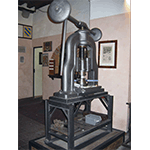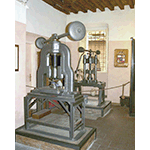Antico Uffizio della Zecca di Lucca [Ancient Mint Office of Lucca]
The origins of the Mint of Lucca date to the 7th century when the first coins ("tremisses" made of gold and bearing the name of the city) were issued under Lombard rule. Under Charlemagne, the right of coinage was maintained and the Carolingian denier was issued, a sort of sole European currency. In the 13th century, the "Luccan gross" was coined with the effigy of the Holy Face, a wooden crucifix venerated in Lucca as the protector of the city. Lucca’s autonomous coining continued until the government of the Baciocchi princes in the early 19th century, when the centesimal-based franc entered circulation and was coined in Lucca until 1817. In 1843, the Bourbon administration brought an end to the activity of the Mint, which in twelve centuries of uninterrupted activity had coined more than 2000 types of coins.
The continuers of the centuries-old tradition of the Mint are today the Old Mint Association of Lucca, created in 1996, and the College of Minters, born the following year. The activities of the College range from the training school for coin engravers to research conducted on the materials in the State Archive of Lucca. Also very important is the activity of the Association and the College regarding the production of tokens and commemorative medals, made with the traditional techniques. Every year, the Old Mint revives the coinage of the historical issues, in the intent to rediscover and valorise the age-old working methods. In this conservation effort aimed at valorising its historical heritage, the Old Mint has restored the old machinery, setting up a coining workshop, and has organised an educational and museum exhibition on the ground floor of the building next to the Palazzo Guinigi.
Datable from the 17th century to the 20th century, the collection mainly consists of machinery and utensils for coining: screw-presses (including an 1824 press from the Bourbon Mint), a Javier-Bercheaut bidimensional pantograph of the early 20th century, punches, chisels for creating planchets, and melting-pots. These are joined by a collection of scales (including an eighteenth-century wall balance), trebuchets and coin scales. The collection also comprises an eighteenth-century safe, a small selection of minerals of Tuscany from which the metals for coins were extracted, and a vast numismatic collection.
****************************
Texts by Graziano Magrini
English translation by Victor Beard
Last update 01/apr/2009





